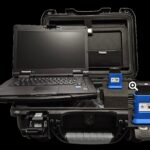A fuse and relay box is a critical component in any vehicle’s electrical system. It houses fuses and relays that protect circuits from overloads and allow low-current switches to control high-current devices. Understanding its function is crucial for any car owner.
Protecting Your Car’s Electrical System with Fuses
Fuses are designed to protect electrical circuits from damage caused by excessive current flow. They act as sacrificial devices, breaking the circuit when the current exceeds a predetermined level. This prevents damage to more expensive components like wiring, sensors, and actuators. Each fuse is rated for a specific amperage, matching the needs of the circuit it protects. When a fuse blows, it indicates a potential problem in the corresponding circuit that needs to be addressed.
Relays: Small Switches, Big Power
Relays enable small switches to control high-current components without being directly connected to the high amperage load. They work by using a small current to activate an electromagnet, which in turn closes a switch for a much larger current. This offers several advantages:
Enhanced Safety
Relays prevent overloading low-current switches, commonly found on dashboards. These switches are not designed to handle the high amperage required by components like off-road lights or cooling fans. By using a relay, the high current flows through the relay’s contacts, protecting the switch and preventing potential fire hazards.
Multiple Circuit Control
A single switch can control multiple circuits with the help of relays. Since the switch only activates the relay’s low-current coil, it can handle the combined load of multiple relays without being overloaded. This is useful in applications like simultaneously activating a compressor and a fan.
Cost Savings
Utilizing relays reduces the need for expensive high-amperage wiring and components. Since the high current is confined to a shorter distance, from the relay to the component, thinner and less expensive wiring can be used for the remainder of the circuit.
Inside the Fuse and Relay Box
The fuse and relay box typically contains a variety of fuses and relays, each responsible for a specific circuit. The box is usually located under the hood or dashboard and may be labeled with a diagram indicating which fuse or relay corresponds to each circuit. This diagram is essential for troubleshooting electrical problems. Accessing this box allows for easy replacement of blown fuses or faulty relays, ensuring the proper functioning of the vehicle’s electrical system.
Maintaining Your Fuse and Relay Box
Regularly inspecting the fuse and relay box is recommended. Look for blown fuses (indicated by a broken filament) or signs of corrosion. Consult your vehicle’s owner’s manual for the correct fuse and relay types and amperage ratings for replacement. Always use the specified rating to avoid potential damage.
In conclusion, the automotive fuse and relay box plays a vital role in protecting and controlling a vehicle’s electrical system. Understanding its function and performing regular maintenance will contribute to the safe and reliable operation of your vehicle.
